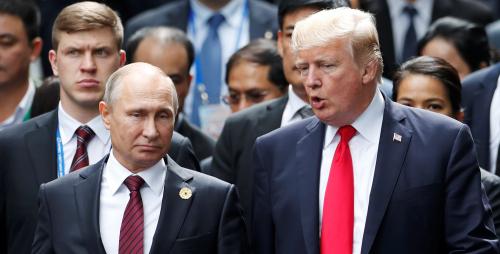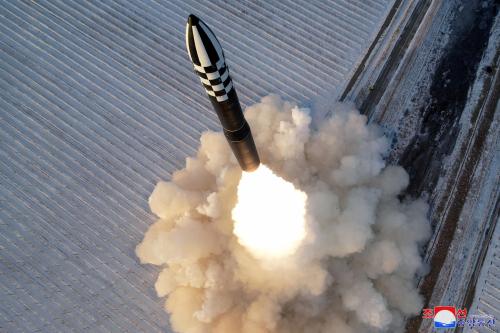Now that U.S. Secretary of State Tillerson and Russian Foreign Minister Lavrov have agreed in principle, to resume strategic stability talks, the two countries should do so expeditiously, writes Steven Pifer. They should tackle measures to reduce the risk of accident or miscalculation, preserve the 1987 Intermediate-range Nuclear Forces (INF) Treaty, and extend the 2010 New Strategic Arms Reduction Treaty (New START). This piece originally appeared on Russia Matters.
Secretary of State Tillerson and Russian Foreign Minister Lavrov have agreed in principle to resume strategic stability talks. The United States and Russia should begin the talks expeditiously, and the first agenda items they should tackle include measures to reduce the risk of accident or miscalculation, preservation of the 1987 Intermediate-range Nuclear Forces (INF) Treaty, and extension of the 2010 New Strategic Arms Reduction Treaty (New START).
Laying the Groundwork
Even if renewed strategic stability talks do not result in early agreements or negotiations on specific topics, the agreement to resume them is welcome. They can provide an important forum for dialogue at a time when U.S.-Russia relations have hit a low point. The talks should be wide-ranging, reflecting the changing character of strategic stability. U.S. and Soviet officials long ago came to a common understanding that strategic stability referred to a situation in which neither side had an incentive to strike first with nuclear weapons, even in an intense crisis. That was because the other would retain surviving nuclear forces that could still decimate the attacker. During the Cold War and its immediate aftermath, strategic stability was a U.S.-Soviet/Russia construct, measured by the numbers of strategic nuclear weapons and missile and air defenses. Increasingly, however, other factors merit attention, such as precision-guided conventional strike weapons and third-country nuclear forces. Moreover, the new cyber and space domains should figure into the equation. Strategic stability is becoming a multilateral, multi-domain concept.
The sides thus have much to discuss. Some questions—such as future arms control arrangements—could be addressed, though there appears to be little prospect of negotiations beginning quickly.
An exchange on military doctrines would prove useful. For example, Russian non-governmental experts claim that the “escalate to de-escalate” doctrine—which postulates the use of low-yield nuclear weapons to terminate a conventional conflict, perhaps initiated by Russia, on terms favorable to Moscow—has never been part of official Russian policy. While public Russian government documents do not incorporate it, the concept is certainly discussed a lot in Moscow—so much that the Pentagon and NATO are adjusting their nuclear planning to take account of it. It would be useful for the sides to come to a common understanding of that doctrine and its status.
Several issues should be addressed as a matter of urgency. That is because they could undermine an already difficult U.S.-Russia relationship.
Reducing the Risk of Accident and Miscalculation
Encounters—sometimes dangerously close encounters—between U.S./NATO and Russian military units have increased significantly since 2013. Russian aircraft fly more missions near or in the air space of NATO members and other European countries than before. U.S. and NATO fighter aircraft often intercept and escort them.
In the aftermath of Russia’s aggression against Ukraine, U.S. and NATO warships spend more time in the Baltic and Black Seas, sometimes overflown by Russian aircraft. U.S. B-52 and B-1 bombers operate over the Baltic Sea in conjunction with exercises with Baltic NATO members. In addition, NATO has deployed battalions in each of the Baltic States and Poland, bringing them closer to Russian ground forces in Russia proper and the Kaliningrad exclave.
These interactions raise the risk of accident or miscalculation, say when a U.S. Navy commander has a Russian fighter barreling down toward his or her ship. The strategic stability talks should address these issues, with a view to establishing a military-to-military dialogue—U.S.-Russian and/or NATO-Russian—on the question.
Such a dialogue could establish procedures for the safe conduct of operations by U.S., NATO and Russian aircraft and ships when operating in close proximity. They could draw on U.S.-Soviet antecedents: the 1972 Prevention of Incidents at Sea Agreement (which is still in effect, if not always closely observed) and the 1989 Prevention of Dangerous Military Activities Agreement. For example, the latter agreement regulated activities by U.S. and Soviet ground forces along the inner-German border (prior to Germany’s reunification). It could be adapted to cover northern Poland, Kaliningrad, the Baltic States and Russia’s Pskov oblast, with a view to minimizing the risk of misperceptions between ground forces separated by the NATO-Russia border.
This assumes that the Kremlin has not adopted a conscious policy of raising the risk of accident as an element of a strategy to intimidate the West. If it has not, reducing that risk should be in the interest of the United States, NATO and Russia.
Preserving the INF Treaty
The INF Treaty banned the testing and deployment of all U.S. and Soviet (now Russian) ground-launched cruise and ballistic missile with ranges between 500 and 5,500 kilometers. However, in 2014, the U.S. government charged that Russia had violated the treaty by developing a prohibited cruise missile of intermediate range. In 2017, U.S. officials said Russia had begun deploying that ground-launched cruise missile.
Russian officials deny the charge and claim the United States is in violation of the INF Treaty by using intermediate-range ballistic missiles as targets in missile defense tests, by arming unmanned aerial vehicles, and by using a launch system for SM-3 missile interceptors in Romania that could contain offensive missiles, including cruise missiles.
The strategic stability talks would offer a forum for discussing the INF Treaty, the implications of the treaty’s demise and the value of maintaining it. If the sides showed political will, there are ways to resolve their respective compliance concerns.
This is an urgent matter, as time appears to be running out for the INF Treaty. The unraveling of the treaty would make it more difficult to conclude new arms control arrangements or to extend New START.
New START Extension
New START limits the United States and Russia each to no more than 1,550 deployed strategic warheads and no more than 700 deployed strategic ballistic missiles and bombers. The limits take full effect in February 2018.
New START is due to expire by its terms in February 2021, but it can be extended by up to five years with agreement by the sides. If United States and Russia do not extend the treaty (and there is no replacement) and if the INF Treaty collapses, it will be the first time in nearly 50 years when no arms control agreements govern the U.S.-Russian nuclear relationship.
The strategic stability talks should address an early decision to extend New START, which would be a relatively simple matter. Extension would allow continuation of the treaty’s limits as well as the data exchanges, notifications and inspections that yield significant information about the other side’s strategic forces. That obviates the need to make worst-case assumptions.
Extension of New START would be good not only for arms control, it could generate momentum in the broader political relationship. It could present an early “win” for Presidents Trump and Putin—and the White House would not have to fear charges of an unreasonable concession to Russia, as extension would almost certainly receive a strong endorsement from the U.S. military leadership.
The strategic stability talks can resume an important element of U.S.-Russian dialogue. The talks could help take some of the edge off bilateral tensions and stabilize the endangered bilateral nuclear arms control regime. The sides should get the talks going, with a mandate for wide-ranging discussions and instructions to focus on early deliverables, as described above.










Commentary
Taking the edge off U.S.-Russia strategic relations
June 19, 2017